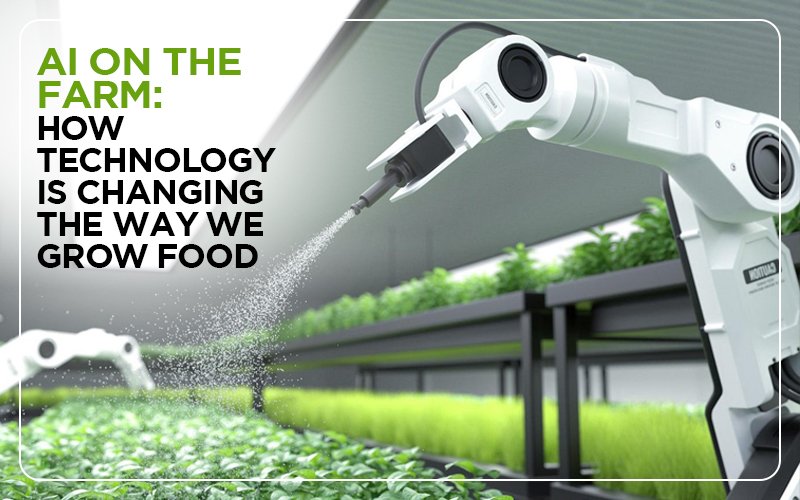
AI on the Farm: How Technology is Changing the Way We Grow Food
Posted on February 3, 2024
As we all know India is known as the land of agriculture. Here the majority of the population depends on this sector for their livelihood. Today, due to many technological advancements, this field is getting modernized by leaving the traditional operations. In these technological advancements, one of the most recent is AI. AI stands for Artificial Intelligence, which basically means performing human intelligence by computer systems. This is becoming the new future of the world. And the agriculture sector is not behind in utilizing this technology. This is surely transforming the way we grow food and promote it in an era of precision agriculture and smart farming.
Traditionally, agriculture has been a game of intuition and hard work. You can even say that it is guided by experience and generational knowledge passed down through families. While these values still hold true, AI is adding a powerful new layer to this equation. Data-driven insights and automated decision-making are its major applications. The power of such computer vision, sensors, and data analytics is being optimized. And farming is getting transformed from planting to harvest and beyond. Let’s delve deeper and understand how technology is changing the way we grow food.
Precision Agriculture: Targeting Every Square Inch
Now that we have mentioned precision agriculture, it must be a query, as what does it even mean? Basically, it is simply doing agriculture with utter precision. Here, all the required materials are provided in exact amounts. Understand by imagining a field where each plant receives the exact amount of water, fertilizer, and pest control it needs. This will be done without waste or overapplication. Hence, this is the promise of precision agriculture. And this has been made possible by drones, satellites, and ground-based sensors. These are like eyes in the sky and beneath the soil. Such instruments gather real-time data on soil. Be it its moisture, nutrient levels, pest infestations, or even plant health.
After this data collection comes the role of AI algorithms. They then analyze this data. Through the analysis, custom maps are generated for the appropriate practice of farming. In addition, targeted recommendations for improvement are also made by such analyses. This approach reduces water and fertilizer waste. Along with this, it boosts yields and minimizes environmental impact as well.
Robots Take the Wheel: From Seeding to Picking
Although India has a lot of human labor, we must remember that human labor is precious and skilled ones are often scarce in the agricultural sector. This is where agricultural robots come into the picture. They take over the tedious and physically demanding tasks. If we look precisely, autonomous tractors that are equipped with GPS and machine learning algorithms now navigate fields. The fields are clearly prepared with precision in planting seeds, applying pesticides, and weeding rows without any human intervention. In addition, harvesting robots are also making their mark. These gently pick delicate fruits and vegetables. This reduces losses and ensures optimal ripeness. These robotic workhorses free up farmers to focus on higher-level tasks. Therefore, improve efficiency and productivity across the farm.
Data Analytics: Seeds of Insight
This AI revolution in agriculture is all about data analytics. Every sensor, drone flight, and robot movement generate a lot of data. And this data is waiting to be unlocked. This wait is completed by machine-learning algorithms. These algorithms analyze this data and discover patterns and trends that human eyes might miss. These insights then allow the farmers to predict weather patterns and optimize irrigation schedules. In addition, it helps identify potential crop diseases early and make informed decisions about every aspect of their operations. And the most important part is that with each passing season, the AI model learns and adapts. Thus eventually becoming highly sophisticated and valuable.
Decision Support Systems: Guiding the Hand That Feeds
AI has the best weapon in the form of decision support systems (DSS). These AI-powered decision support systems (DSS) act as virtual farmhand advisors. These provide farmers with real-time recommendations based on historical data, current conditions, and even future forecasts. They can receive alerts about a pest outbreak or be directed to a field that needs immediate irrigation. AI can even suggest the appropriate harvesting time for maximum yield. Hence, these DSS become invaluable tools. Thus, empower farmers to make informed decisions, mitigate risks, and eventually maximize their returns.
The Challenges and Opportunities Ahead
While the potential of AI in agriculture is vast, challenges still remain. Let’s understand some of them:
- The initial investment in such infrastructure and AgTech (Agricultural technology) can be difficult for small-scale farmers.
- Accessibility to reliable Internet of Things (IoT) connectivity in rural areas can also be a hurdle.
- Ethical considerations regarding data privacy are also there.
- The potential for large corporations to dominate the agricultural landscape also needs careful attention.
